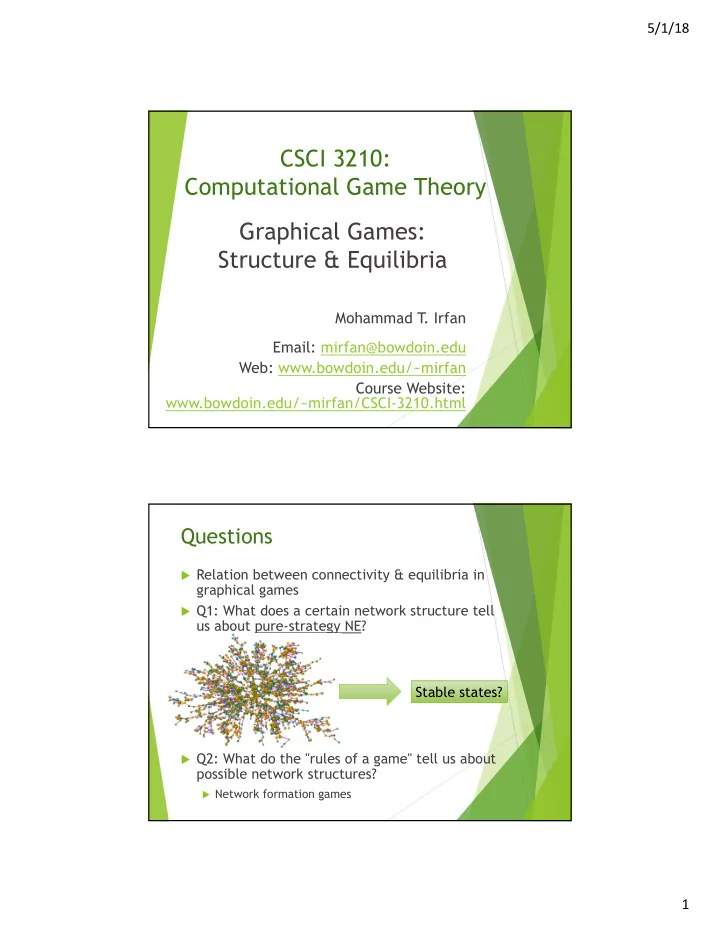

5/1/18 CSCI 3210: Computational Game Theory Graphical Games: Structure & Equilibria Mohammad T . Irfan Email: mirfan@bowdoin.edu Web: www.bowdoin.edu/~mirfan Course Website: www.bowdoin.edu/~mirfan/CSCI-3210.html Questions u Relation between connectivity & equilibria in graphical games u Q1: What does a certain network structure tell us about pure-strategy NE? Stable states? u Q2: What do the "rules of a game" tell us about possible network structures? u Network formation games 1
5/1/18 Q1 starting point: random graphs u Provides a basis for understanding richer structures u Powerful: Randomization abstracts a huge number of instances (ensemble of networks) u Context-free: independent of the story behind probabilities Erdos-Renyi random graphs or random graphs u Static u Given n nodes (n doesn’t grow over time) u Variant I u Inputs: number of nodes n and number of edges m u Create m edges uniformly at random out of n C 2 total possible edges u Variant II: G(n, p) u Inputs: number of nodes n and probability of forming an edge = p 2
5/1/18 Example: Random graph with p = 0.02 Example: Random graph with p = 0.08 3
5/1/18 Random graphical game u Random payoff table for each player u m k+1 payoff values for m actions and k neighbors u Payoff values are independent and identically distributed according to some distribution (e.g., uniform) u 2 sources of randomness u Graph G(n,p) is randomly created u Payoffs are randomly assigned Average degree & existence of pure-strategy NE u Nonmonotonic relation w.r.t. average degree Random graph with Empty graph Complete graph "medium connectivity" prob = 1 prob = 1 – 1/e prob = 0 as n à + ∞ [Dresher (1970)] [Daskalakis+ (2011)] Probability of existence of pure-strategy NE 4
5/1/18 Impact of network topology on equilibria Dilkina+ (AAAI 2007) Topologies considered Path Tree Star "Augmented" complete bipartite Complete bipartite 2-action random games Payoffs are assigned uniformly at random 5
5/1/18 Example u Is there a pure NE in this game? p q r Best-response tables (each is randomly chosen among all possibilities) Results complete graph 6
5/1/18 Path u Probability of pure-strategy NE <= (63/64) n-1 in n-node paths u Proof idea u Probability of no pure NE in n-node path, given the best response table of a boundary node = f(Probability of no pure NE in (n-1)-node path) Empirical results: different topologies 7
5/1/18 Empirical results: Tree games– random vs. preferential attachment (Strategic) Network Formation Games Handout [Jackson & Wolinsky] and Ch 19.1, 19.2 [AGT] 8
5/1/18 Network formation games u Q2: What do the "rules of a game" tell us about possible network structures? u Examples u Network infrastructure u Trading relationship u Political alliances u Professional collaborations u Friendships Challenges 1. Explicitly model costs and benefits Individual incentives to form or sever links u Overall societal welfare from a network u 2. Predict how individual incentives translate to network formation Equilibrium methods u Why do we see a particular type of network (e.g., u why preferential attachment)? 9
5/1/18 Individual vs. society u Tension between individual incentives and societal welfare u Price of stability (to be defined) u Price of anarchy (later) Model (Jackson and Wolinsky, 1996) u Nodes: {1, 2, ..., n} u Payoff of each node: function of network u "connectedness" – cost of forming links u Forming/severing links u Mutual consent needed to form a link u Severing link needs the consent of only one player u Does the traditional concept of Nash stability (NS) apply here? 10
5/1/18 Equilibrium concept: "pairwise stability" u A network is pairwise stable if No player wants to unilaterally sever a link, and 1. No two players both want to form a new link 2. (i.e., in a pairwise stable network, if there does not exist an edge (i, j), it means that i or j or both will suffer from forming this edge) Limitations of pairwise stability u Allows deviations on only a single link at a time u Does not allow a group of more than 2 players to form links at a time 11
5/1/18 Nash stability (NS) vs. Pairwise stability (PS) u NS: A node/player can unilaterally sever multiple links at once, but a pair of nodes are not allowed to form a new link! u PS: A node cannot sever multiple links at once Results u Depending on the level of benefits from forming links: u Complete network u Star u Empty network 12
5/1/18 Model (Fabrikant+, 2003) u Players are nodes u Action/strategy of a player u : Set of undirected edges that u will pay for u Other player(s) with whom u connects will not pay u Cost (opposite of payoff) of player u : dist(u, v) is +infinity if no path bet'n u & v Cost of each edge n u = Number of edges player u bought u Solution concept: traditional NE Possible NE outcomes u alpha >= 1 è Star is NE u alpha <= 1 è Complete graph is NE Cost (opposite of payoff) of player u : 13
5/1/18 Social cost of a network u The sum of players' costs Note: double counting dist(u, v) and dist(v, u) Socially optimal networks u alpha >= 2 è Star is socially optimal u alpha <= 2 è Complete graph is optimal u Proof. u Cost of a network with m edges >= alpha * m + 2 * [n(n-1) - 2m] + 2m Any pair (i, j) not connected by an edge has distance >= 2 = (alpha – 2) m + 2 n (n - 1) u Want to avoid disconnected graph (why?) 14
5/1/18 Price of stability (PoS) u Def. PoS = least cost of a NE/cost of social opt. u 1 < alpha < 2: PoS <= 4/3 (NE is star, social opt is complete graph) u Proof. Simple ratio of costs for alpha à 1 u Otherwise: PoS = 1 (NE matches social opt) 15
Recommend
More recommend